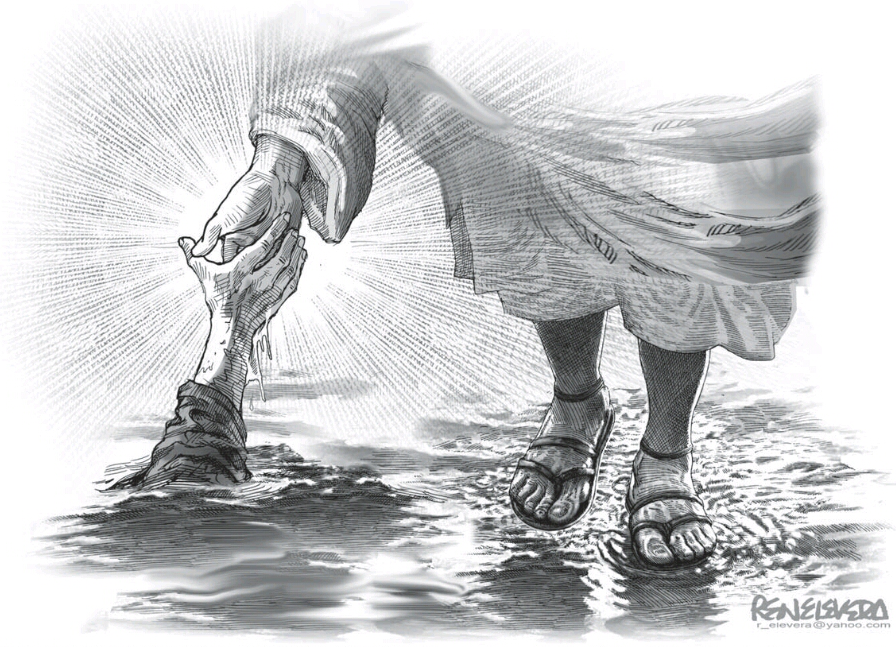Francois Boucher’s painting, “Saint Peter Attempting to Walk on Water,” comes across as an odd man out. Boucher, a French rococo painter who lived in the first half of the eighteenth century, built his reputation as a painter largely upon his portrayal of voluptuous women, as in such works as Leda and the Swan, The Toilet of Venus and the Odalisque portraits.
It goes without saying that “Saint Peter Attempting to Walk on Water” draws from the account of a miracle narrated in the Gospels of Matthew, Mark and John. After he had fed five thousand people, Jesus sent the disciples on a boat to the other side of the Sea of Galilee, while he remained behind to pray. Night came, a storm arose and the disciples saw Jesus walking on the water towards them. At first they thought that they saw a ghost, but Jesus reassured them and told them not to be afraid. Jesus joined them in the boat and calmed the storm.
In Matthew’s account, when Jesus called out to the disciples, saying, “Courage! It is I! Do not be afraid,” Peter answered, “Lord, if it is you, tell me to come to you across the water.” Jesus told him to come, and “Peter got out of the boat and started walking towards Jesus across the water, but as soon as he felt the force of the wind, he took fright and began to sink.” “Lord! Save me!” Peter cried. Jesus reached out to him and held him, saying, “Man of little faith, why did you doubt?”
They both got into the boat and the wind abated. Matthew concludes his account with this line — “The men in the boat bowed down before him and said, ‘Truly, you are the Son of God.’”
Boucher’s painting portrays the moment when Jesus holds out his hand towards Peter. Consonant with Boucher’s stylized treatment, characteristic of the rococo approach, Jesus and Peter retain their grace despite the stormy weather, their clothes elegant and flowing.
Peter, however, displays the pleading and helpless countenance that the cry in Matthew’s account suggests, “Lord! Save me!” In pink inner garment and blue tunic (Boucher favored pinks and blues), Jesus looks at Peter with commensurate mercy, not reproving so much as reminding, “Man of little faith, why did you doubt?”
All the while, from the boat, the disciples watch, one of them raising a hand towards Jesus and Peter, as though distressed by the sight of Peter sinking. In the sky cherubs float in the eye of the storm, rimming a circle of glimmer that hints at the impending calm and the worship that the disciples would give to Jesus in the boat, “Truly, you are the Son of God.”
Incidentally, Boucher enjoyed the patronage of Madame de Pompadour, the chief mistress of Louis XV, who reportedly kept herself attractive by, among other designs, having Boucher regularly do her portrait that called attention more to her physical assets than her liabilities. Pop history remembers her for comforting Louis XV with these words, when France lost to Prussia during the Seven Years’ War—“Au reste, après nous le Deluge” (Besides, after us, the Déluge).
How did Boucher come to paint “St. Peter Attempting to Walk on Water”? To be sure, he had other religious paintings, such as “Hagar and Ishmael in the Desert,” “Joseph Presenting His Father and Brothers to Pharaoh,” “The Dream of St. Joseph,” “Nativity,” and “Adoration of the Magi.”
But who knows if, as artist and human being, Boucher considered “St. Peter Attempting to Walk on Water” as closest to his heart. Because creation — whether in painting, music or poetry — and indeed all living require walking on water.
Rainer Maria Rilke describes the experience in his poem, “Moving Forward”:
The deep parts of my life pour onward,as if the river shores were opening out.
It seems that things are more like me now,
That I can see farther into paintings.
I feel closer to what language can’t reach.
With my senses, as with birds, I climb
into the windy heaven, out of the oak,
in the ponds broken off from the sky
my falling sinks, as if standing on fishes.
